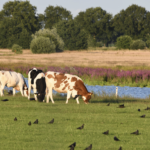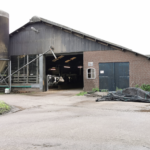(First published on June 13, 2017)
Jonathan Verschuuren
(Photo: Flickr user Kai C. Schwarzer)
Soils contain large quantities of carbon, mainly made up of decomposing plant materials and microbes. The Earth’s soils contain around 2500 Gt of carbon, four times more than vegetation.[1] Through soil degradation, much of natural soil carbon stocks has been lost. It has been estimated that the carbon sink capacity of the world’s agricultural and degraded soils is 50 to 60% of the historical carbon loss of 42 to 78 Gt of carbon.[2] With around 40% of the world’s surface being used for agriculture, it is suggested that these agricultural lands may be used as an important sink for atmospheric carbon.[3] Soil erosion control and soil restoration has an estimated carbon sequestration capacity of between 5 and 15% of global emissions.[4] After peaking, a new equilibrium will be reached and the sequestration potential goes down. It should also be noted that the carbon stored in soils can be easily emitted again with deep tillage and significant soil disturbance.[5]
Increasing soil carbon sequestration has a very interesting positive impact on climate change adaptation. Measures aimed at soil carbon sequestration increases the ability of soils to hold moisture and to better withstand wind and water erosion, enriches ecosystem biodiversity, helps cropping systems to better withstand droughts and floods, increases fertility for crops through restoring healthy soil microbial communities, and increases livestock efficiency (sustainable intensification).[6] Other potential positive side-effects of practices aimed at soil carbon sequestration are various environmental benefits, such as avoided use of chemical fertilizers and pesticides and improved biodiversity and wildlife.[7]
Examples of soil carbon sequestration practices relevant for Europe are the application of conventional or organic no-till and conservation tillage systems, the use of periodic green fallows, winter cover crops and crop rotations that utilize semi-perennial crops, rotational grazing, decreased grassland management intensity, perennial cropping, nutrient management consisting of compost (crop residue addition) and organic manure, and judicious use of irrigation water.
Research shows that strong top-down policies that are linked with, and fed by, bottom-up initiatives, are needed to achieve the required level of adaptation in the agricultural sector.[8] Holistic strategies have to be adopted that go beyond technical approaches aimed at stimulating autonomous farm-level risk reduction. So far, the EU did not focus much attention on agriculture in its climate change adaptation policy. The EU’s Adaptation Strategy refers to the Common Agricultural Policy (CAP) in which adaptation measures have been integrated to a limited extent.[9] An assessment of the soil carbon related adaptation potential of the current CAP, however, shows that this potential is limited. Soil carbon projects can receive funding both under the green direct payments, and under the rural development policy. Whether such projects are actually carried out with CAP funding depends entirely on initiatives by farmers (for green direct payments), or by Member States (for the rural development policy). Unfortunately, there are not many indications that Member States radically focus their Rural Development Programmes (RDP) on climate change, perhaps with the exception of Ireland. The CAP also has several inherent constraints as far as soil carbon sequestration and associated adaptation are concerned, mostly due to the fact that CAP is not linked to the EU climate policy but serves as a separate instrument with a much wider policy goal than combatting climate change. The accounting rules, for example, do not require farm level quantification of the amount of carbon sequestered linked to the payment, so it cannot be assessed whether and in how far an increase in soil carbon levels is real, additional and verifiable. Integrating the CAP more into the EU’s climate policy requires rules to be set in place to assure a reliable measuring of the carbon sequestered. Payments, to give another example, are based on the amount of hectares per year of measures under the RDP, not on the amount of CO2 sequestered. This is a consequence of the provision that payments can only cover additional costs and income forgone resulting from the commitments made.[10] Such indirect payments, therefore, do not stimulate farmers to sequester as much carbon as possible. A third example of the CAP’s shortcomings with regard to soil carbon sequestration is that projects financed under the CAP are characterized by a relatively short lifespan, 1-5 years for green direct payments, and 5-7 years for projects under a RDP. Under a climate policy, such a lifespan is almost futile, as combatting climate change requires measures that cover decades, if not the entire 21st century. That is why in Australia, carbon sequestration projects are required to run for twenty five or even a hundred years (see blog posts on Australia’s carbon farming legislation part 1 and part 2).
Towards an alternative approach: agriculture in the EU ETS
The conclusion that the current EU policy is completely inadequate to stimulate large scale soil carbon sequestration on agricultural land seems inevitable, also when taking into account the broader climate change mitigation policy. The recently presented proposal for a European Regulation on the inclusion of greenhouse gas emissions and removals from land use and forestry into the EU’s 2030 climate framework (LULUCF Regulation) is a good first, yet inadequate, step towards including agriculture’s emissions and sequestration potential into the EU’s climate policy (see for broader assessment of the climate policy instruments, the paper). That is why an alternative approach needs to be developed. A further stimulus to the adoption of soil carbon projects that currently is not being discussed but that needs to be investigated at European level soon is the inclusion of agriculture in the EU ETS through allowing regulated industries to buy offsets from the agricultural sector, following the examples set by California, Alberta, Australia, and more recently also China.[11] These states show that it is possible to stimulate soil carbon sequestration (and other climate smart agriculture practices and technologies) through the ETS, provided an elaborate regulatory regime has been put in place to ensure integrity. When in place, sectors covered by the ETS will be allowed to finance sequestration projects on farm land, thus paying farmers for their efforts.
The recent report of the Agricultural Markets Task Force, a European Commission expert group, also proposes to incentivise to farm carbon in addition to crops. The Task force, however, proposes to do this through redirecting funds under the CAP after 2020. It is debatable, though, whether this will be a successful strategy given the inherent shortcomings mentioned above. Some of the current constraints can perhaps be repaired, such as the short commitment period, or the provision that payments can only cover additional costs and income forgone. It is highly unlikely, though, that the CAP budget will be big enough to cover an EU wide adoption of carbon farming practices. An evaluation of the Australian carbon farming legislation indicated that government funds will never suffice to roll out an incentive mechanism across all farms in the country and that private funds need to come in, either through a carbon tax or an ETS.[12] The latter seems very suitable for the EU with its well-developed ETS that, hopefully, will pick up speed again after the structural reform takes effect in the fourth trading phase, which runs from 2021 until 2030. Regulation aimed at establishing a finance flow from large industrial emitters to the farming sector, with its capacity to sequester large quantities of carbon on farm land, seems a promising alternative, which is completely in line with the polluter pays principle as laid down in Article 191(2) of the Treaty on the Functioning of the EU.
[1] Daniel Kane, Carbon Sequestration Potential on Agricultural Lands: a Review of current Science and Available Practices (Breakthrough Strategies & Solutions, Takoma Park, Md 2015).
[2] Emanuele Lugato et al., ‘Potential carbon sequestration of European arable soils estimated by modelling a comprehensive set of management practices’, (2015) 20 Global Change Biology 3557.
[3] Pete Smith, ‘Agricultural Greenhouse Gas Mitigation Potential Globally, in Europe and in the UK: What Have We Learnt in the last 20 Years?’ (2012) 18 Global Change Biology 35.
[4] M.G. Rivera-Ferre et al., Re-framing the Climate Change Debate in the Livestock Sector: Mitigation and Adaptation Options, (2016) 7 WIREs Climate Change 869.
[5] Ibid.
[6] P. Smith et al., ‘Agriculture, Forestry and Other Land Use (AFOLU)’ in: O. Edenhofer et al. (eds.), Climate Change 2014: Mitigation of Climate Change. Contribution of Working Group III to the Fifth Assessment Report of the Intergovernmental Panel on Climate Change (Cambridge University Press 2015), 811, 846 and 847; J.R. Porter et al., ‘Food security and food production systems’ in: C.B. Field et al. (eds.), Climate Change 2014: Impacts, Adaptation, and Vulnerability. Part A: Global and Sectoral Aspects. Contribution of Working Group II to the Fifth Assessment Report of the Intergovernmental Panel on Climate Change (Cambridge University Press 2015), 485, 515 and 518.
[7] Annette Freibauer et al., ‘Carbon Sequestration in the Agricultural Soils of Europe’ (2004) 122 Geoderma 1.
[8] L. Bizikova et al., Climate Change Adaptation Planning in Agriculture: Processes, Experiences and Lessons Learned from Early Adapters, (2014) 19 Mitigation and Adaptation Strategies for Global Change 411.
[9] Communication from the Commission to the European Parliament, the Council, the European Economic and Social Committee and the Committee of the Regions, An EU Strategy on Adaptation to Climate Change, COM (2013) 0216 final, 8.
[10] Art. 28(6) Regulation (EU) No 1305/2013.
[11] Jonathan Verschuuren, Towards a Regulatory Design for Reducing Emissions from Agriculture: Lessons from Australia’s Carbon Farming Initiative, (2017) 7:1 Climate Law 1; Dong Sun et al., Carbon Markets in China: Development and Challenges, (2016) 52:6 Emerging Markets Finance and Trade 1361.
[12] Verschuuren 2017.
—————————–
This blog is a summary of a paper accepted for presentation at the 3rd European Climate Change Adaptation Conference ‘Our Climate Ready Future’, Glasgow, 5th-9th June 2017 (ECCA2017). My project has received funding from the European Union’s Horizon 2020 research and innovation programme under the Marie Sklodowska-Curie grant agreement No 655565.



